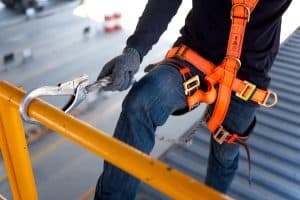Did Your Safety Harness Cause Your Injuries?
 Using safety harnesses correctly is important to your safety, whether you’re at your job or working on a project at home. If you do not use them correctly, or if they do not work well, it can lead to serious injuries. Harnesses have specific safety features, and it’s crucial to make sure they fit properly, are attached securely, and that you follow all safety rules. If you don’t use them the correct way, you risk falling, getting hurt on impact, or even facing issues like suspension trauma. Improper use can cause physical injuries like sprains, fractures, head injuries, and even cardiac arrest. When using safety harnesses, following the guidelines is important to keeping you and others safe.
Using safety harnesses correctly is important to your safety, whether you’re at your job or working on a project at home. If you do not use them correctly, or if they do not work well, it can lead to serious injuries. Harnesses have specific safety features, and it’s crucial to make sure they fit properly, are attached securely, and that you follow all safety rules. If you don’t use them the correct way, you risk falling, getting hurt on impact, or even facing issues like suspension trauma. Improper use can cause physical injuries like sprains, fractures, head injuries, and even cardiac arrest. When using safety harnesses, following the guidelines is important to keeping you and others safe.
What injuries are caused by a defective or malfunctioning safety harness?
A failing harness poses a range of risks, leading to various injuries depending on the circumstances and severity of the failure. The primary consequence is the potential for falls from high places, resulting in injuries such as fractures, sprains, and contusions upon impact with a lower level or structure. Impact injuries are exacerbated if the harness malfunctions during a fall arrest, leading to significant force upon landing. Additionally, strap-related injuries may occur if components of the harness break, causing lacerations, abrasions, or bruising.
Neck and throat injuries are possible if the harness fails to secure the upper body properly. Internal injuries may occur due to severe impacts or sudden stops, affecting organs such as the lungs, liver, or spleen. To help prevent these types of injuries, it is important to be meticulous when selecting, using, and maintaining your safety harnesses.
What is suspension trauma?
Suspension trauma, also known as harness hang syndrome or orthostatic intolerance, is a potentially life-threatening condition that can occur when a person is suspended in an upright position for an extended period, typically while wearing a safety harness. This situation often arises in work-related scenarios, such as construction or rescue operations, where individuals may be suspended after a fall. When a person is left hanging, the straps of the harness can place significant pressure on the legs, leading to reduced blood circulation, also known as vasodilation. While vasodilation is a normal response aimed at increasing blood flow and oxygen delivery to tissues, in the context of suspension trauma, it contributes to a series of adverse effects.
As the blood vessels dilate, blood pools in the lower extremities, resulting in reduced venous return to the heart. This diminished blood flow can lead to a drop in blood pressure and compromise the overall circulation. In turn, insufficient blood supply to vital organs, especially the brain, may occur, causing symptoms such as dizziness, fainting, and, in severe cases, unconsciousness. The real danger lies in the potential development of serious medical complications, including unconsciousness and, in extreme cases, cardiac arrest.
Prompt rescue and medical attention are crucial to mitigate the risks associated with suspension trauma, and preventive measures such as regular training, proper equipment use, and adherence to safety protocols are essential in high-risk work environments.
What can cause your harness to malfunction?
Wearing a fall protection harness incorrectly can lead to serious injuries, emphasizing the importance of understanding its proper usage. Potential causes of harness malfunction while wearing a harness include:
- D-Ring positioning and attachment. The D-ring should be precisely centered between the shoulder blades to ensure proper force distribution, and attaching the lanyard to the correct D-ring is crucial for a safe fall arrest.
- Harness is too loose or too tight. The harness must be appropriately adjusted for a secure fit, avoiding issues like circulation problems or rupturing caused by overly loose or tight straps.
- Incorrect positioning of chest strap. Correct positioning of the chest strap is essential to prevent choking or slipping out during a fall.
- Twisted straps. Twisted straps can significantly reduce the harness’s strength.
Regular checks and adherence to proper usage guidelines are emphasized, highlighting that harnesses are not just tools but life-saving devices, with their effectiveness dependent on correct utilization.
Who is liable for my harness injury on an Oklahoma City construction site?
If your work harness malfunctions and you suffer an injury, prioritize your health by seeking immediate medical attention. Report the incident to your supervisor, providing details of the malfunction and your injuries. Document the scene, take photographs, and gather witness statements if possible. Preserve the harness and related equipment as evidence, avoiding alterations until authorities investigate. Follow your workplace’s protocols for reporting injuries, and consult with a medical professional for a thorough assessment. If your injuries are significant or you suspect negligence, consider seeking legal advice from a professional familiar with workplace injuries to explore potential courses of action and safeguard your rights. Always prioritize your well-being and adhere to the specific procedures outlined by your workplace and jurisdiction.
At Cunningham & Mears, we understand the profound impact that a defective harness can have on an individual’s safety and well-being. Defective harnesses pose a serious risk, potentially resulting in injuries that range from falls and fractures to more severe complications. Our Oklahoma City injury lawyers are dedicated to advocating for those who have suffered harm due to such defects. We recognize the importance of thorough investigation and documentation, and we leverage our experience and skill in product liability law to assess the circumstances surrounding the incident.
If you or a loved one has experienced injuries due to a defective harness, our experienced attorneys are here to help. We will work diligently to gather evidence, collaborate with experts, and build a strong case on your behalf. Our commitment is to seek fair compensation for your injuries, medical expenses, and any other damages incurred. At Cunningham & Mears, we stand by your side, advocating for justice and holding those responsible for the defective harness accountable. To schedule a free consultation, call us today in Oklahoma City, or fill out our contact form.

Ryan Y. Cunningham is a founding partner of Cunningham & Mears. Mr. Cunningham devotes his practice to protecting the rights of injured Oklahoma residents. In addition to assisting injured clients, Mr. Cunningham endeavors to improve personal injury representation by speaking on issues related to personal injury law to attorneys in continuing legal education courses and to law students. Learn More
